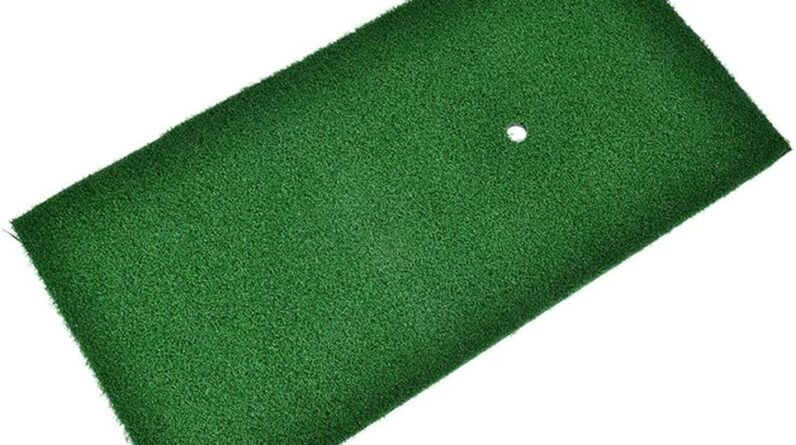If you are looking to enhance your golf swing and elevate your game to new heights, then you have come to the right place. In this article, we will explore effective techniques and helpful tips that will help you improve your golf swing and achieve better results on the course. So, whether you are a beginner looking for some guidance or an experienced golfer seeking to refine your technique, get ready to unlock the secrets to a powerful and precise golf swing.

1. Evaluate Your Current Swing
1.1 Understanding the Basic Components of a Golf Swing
To improve your golf swing, it’s important to understand the basic components that make up a successful swing. These components include the grip, stance, posture, alignment, and balance. The grip refers to how you hold the club, while the stance and posture involve the positioning of your feet, body, and arms. Alignment refers to how you position yourself in relation to the target, and balance ensures stability throughout your swing.
1.2 Recording and Analyzing Your Swing
Recording and analyzing your golf swing can provide valuable insights into areas that need improvement. Use a smartphone or a dedicated camera to record your swing from different angles. This will allow you to review the video and identify any flaws or areas that can be enhanced. Look for things like swing plane, clubface position, and body positioning to identify any areas of improvement.
1.3 Seeking Professional Evaluation
While self-analysis is helpful, seeking professional evaluation can greatly expedite your progress. A golf instructor or coach can provide expert guidance and identify specific areas where your swing needs improvement. They can offer personalized drills, exercises, and feedback tailored to your specific needs and goals. Working with a professional can help you address any swing issues more effectively and efficiently.
2. Develop Solid Fundamentals
2.1 Grip
A proper grip is crucial for a consistent and powerful golf swing. Place the club in the fingers of your left hand (for right-handed golfers) and position your right hand to match. The grip should be firm but not overly tight, allowing for proper wrist hinge during the swing. Experiment with different grip styles, such as the overlap, interlock, or baseball grip, to find what feels most comfortable and natural for you.
2.2 Stance and Posture
Achieving the right stance and posture sets the foundation for a successful swing. Stand with your feet shoulder-width apart, aligning them parallel to the target line. Bend your knees slightly and tilt your upper body forward from the hips. Your spine should be straight but not rigid, and your weight should be evenly distributed between your feet. Maintain a relaxed and athletic posture throughout your swing.
2.3 Alignment
Proper alignment is essential for consistently accurate shots. To align yourself correctly, imagine a straight line running from your target to your ball. Position your feet, hips, and shoulders parallel to this line. Use visual alignment aids, such as targets or intermediate objects, to ensure accurate alignment. Developing a consistent pre-shot routine that includes alignment checks will help ingrain this fundamental aspect of your swing.
2.4 Balance
Maintaining balance throughout your swing is crucial for both control and power. Proper weight distribution and stability allow for a more efficient transfer of energy from your body to the club. Start with a balanced setup and maintain a stable base throughout your swing. Avoid any excessive weight shifts or swaying that may cause loss of control or power. Strengthening your core muscles through targeted exercises can greatly enhance your balance.
3. Improve Your Body Mechanics
3.1 Core Strength and Stability
A strong and stable core is essential for generating power and maintaining control in your golf swing. Incorporate exercises that target your core muscles, such as planks, Russian twists, and medicine ball rotations. By developing a strong core, you can stabilize your body during your swing and generate greater clubhead speed.
3.2 Flexibility and Range of Motion
Flexibility and range of motion are crucial for achieving an efficient and fluid swing. Incorporate exercises that focus on stretching and improving the flexibility of your shoulders, hips, and spine. Implementing a regular stretching routine, both before and after your golf sessions, can help improve your overall flexibility and enhance your swing mechanics.
3.3 Rotational Power and Coordination
Generating rotational power and coordinating your movements is vital for a powerful and consistent swing. Include exercises that focus on rotational movements, such as medicine ball throws, cable rotations, and torso twists. These exercises will help strengthen and coordinate your upper and lower body, enabling you to generate more clubhead speed and achieve better ball striking.
3.4 Addressing Common Swing Faults
Identifying and addressing common swing faults can significantly improve your overall swing mechanics. Some common faults include a reverse pivot, coming over the top, or poor weight transfer. Working with a golf instructor or coach can help you identify and correct these faults through specific drills and exercises targeted to your individual needs.
4. Work on Tempo and Timing
4.1 Establishing a Smooth Rhythm
Having a smooth and consistent tempo is crucial for a well-executed golf swing. Practice swinging the club with a metronome or by counting in your head. Find a tempo that feels comfortable and natural to you, as this will help you maintain consistency and rhythm throughout your swing.
4.2 Understanding the Importance of Tempo
Tempo plays a vital role in swing mechanics, as it allows for proper sequencing and synchronization of the body’s movements. A proper tempo can help maximize power and minimize swing errors. By understanding the importance of tempo, you can focus on developing a consistent and repeatable swing.
4.3 Practicing with a Metronome
Practicing with a metronome can be a helpful tool to develop a consistent tempo and timing. Set the metronome to a tempo that matches your desired swing rhythm, and practice syncing your swing with the beats. This can help ingrain the correct timing and rhythm into your muscle memory, leading to more consistent and controlled swings.
4.4 Developing Consistent Timing
Consistent timing is essential for a consistent and repeatable golf swing. Focus on maintaining a consistent pace throughout your swing, ensuring that your body, arms, and club move together in a synchronized manner. Regular practice and repetition will help develop the muscle memory needed for consistent timing.

5. Master the Takeaway and Backswing
5.1 Initiating the Takeaway
The takeaway is the first movement in your golf swing and sets the tone for the rest of the swing. Keep your hands and wrists relaxed and initiate the takeaway with a slight wrist hinge. As you bring the club back, ensure that it stays on the correct swing plane and remains parallel to your target line.
5.2 Maintaining Proper Club Path
Maintaining a proper club path during the backswing is crucial for a consistent and accurate swing. Focus on keeping the club on the correct swing plane, allowing for a smooth and on-plane transition into the downswing. Practice drills that emphasize proper club path to develop muscle memory and consistency.
5.3 Achieving Synchronized Upper and Lower Body
A synchronized upper and lower body during the backswing helps generate power and maintain control. Coordinate the rotation of your hips and shoulders to achieve a seamless and connected backswing. Avoid any excessive swaying or over-rotation, as this can lead to swing errors.
5.4 Maximizing Power and Distance
Achieving maximum power and distance during your swing is a combination of proper mechanics, timing, and generating clubhead speed. Focus on maintaining a smooth tempo, leveraging your core muscles for power, and maintaining a stable base throughout your swing. Regular strength training and conditioning can also aid in maximizing power and distance.
6. Focus on Impact and Release
6.1 Creating a Strong Impact Position
The impact position is where the ball meets the clubface, and it is crucial for achieving consistent and solid ball striking. Focus on maintaining a forward-leaning shaft at impact, with your hands slightly ahead of the ball. This position ensures a downward strike and solid contact with the ball.
6.2 Generating Lag and Release
Generating lag in your downswing and releasing it effectively is key to maximizing clubhead speed and distance. Lag refers to the angle created between the clubshaft and your lead arm during the downswing. Practice drills that emphasize developing and maintaining lag, as well as properly releasing it for optimal power and accuracy.
6.3 Fixing Common Impact Errors
Common impact errors such as thin shots, fat shots, or slices can be rectified by analyzing and adjusting your impact position. Thin shots usually occur when your hands are too far back at impact, while fat shots occur when your hands are too far forward. Slices can be caused by an open clubface at impact. Work with a golf instructor to identify and correct these errors through targeted drills and adjustments.
6.4 Utilizing the Hands and Wrists Correctly
Proper utilization of your hands and wrists is essential for a well-executed golf swing. Maintain a relaxed grip and allow for natural wrist hinge during the backswing and release through impact. Avoid excessive tension or manipulation with your hands and wrists, as this can lead to swing inconsistencies and loss of control.

7. Enhance Your Downswing
7.1 Initiating the Downswing Properly
Initiating your downswing properly sets the stage for a powerful and consistent swing. Start the downswing by smoothly shifting your weight from your back foot to your front foot while maintaining a connected and synchronized body rotation. This will ensure a well-coordinated and efficient downswing.
7.2 Transitioning from Backswing to Downswing
The transition from the backswing to the downswing is a critical moment in your swing. Focus on maintaining a smooth and fluid transition, avoiding any jerky or rushed movements. This will allow for proper sequencing and timing of your body movements, leading to more consistent and controlled downswings.
7.3 Creating a Powerful and Consistent Downswing
A powerful and consistent downswing is achieved through a combination of proper mechanics, timing, and rhythm. Focus on generating a smooth and controlled acceleration through impact, ensuring that your body, arms, and club work together in harmony. Regular practice and repetition will help ingrain the correct downswing sequence and mechanics.
7.4 Avoiding Common Downswing Mistakes
Several common downswing mistakes can hinder your overall swing performance. These include casting the club, coming over the top, or early release of the wrists. Work with a golf instructor to identify and correct these mistakes through targeted drills and adjustments specific to your swing mechanics.
8. Improve Your Ball Striking
8.1 Achieving a Solid and Centered Contact
Achieving solid and centered contact with the ball is essential for consistent and accurate ball striking. Focus on maintaining a consistent impact position and strike the ball with the center of the clubface. Regular practice and repetition, combined with proper swing mechanics, will help improve your ability to strike the ball cleanly and consistently.
8.2 Generating Consistent Clubface Control
Proper clubface control is crucial for controlling the direction and trajectory of your shots. Focus on developing a repeatable grip, maintaining a square clubface at impact, and avoiding excessive manipulation with your wrists. Regular practice drills that emphasize clubface control will help develop muscle memory and consistency.
8.3 Developing Accuracy and Precision
Improving accuracy and precision in your ball striking comes through a combination of solid mechanics, proper setup, and consistent practice. Focus on developing a consistent pre-shot routine, ensuring proper alignment and posture, and honing your ability to visualize and execute shots accurately. Regular practice and feedback from a golf instructor can help fine-tune your accuracy and precision.

9. Enhance Your Short Game
9.1 Practicing Pitching and Chipping
The short game is a crucial aspect of golf that can greatly impact your overall score. Allocate time to practice pitching and chipping shots, focusing on developing a soft touch, control, and accuracy. Incorporate different practice drills that simulate various scenarios you may encounter on the course, such as uneven lies or challenging green conditions.
9.2 Mastering Bunker Shots
Bunker shots require a specific set of skills and techniques to navigate successfully. Practice bunker shots to develop a consistent and reliable technique. Focus on positioning your feet correctly, utilizing the bounce of the club, and maintaining the appropriate amount of speed and power. Regular practice and experimentation with different bunker shot scenarios will enhance your ability to escape bunkers effectively.
9.3 Perfecting Putting
Putting can make or break your overall score, so dedicating time to perfect this aspect of your game is essential. Focus on developing a consistent and repeatable putting stroke, maintaining proper alignment and posture, and honing your distance control. Practice different putting drills and incorporate reading greens to enhance your ability to sink putts consistently.
9.4 Developing Touch and Feel Around the Greens
Having touch and feel around the greens is crucial for executing delicate shots with precision. Practice shots that require various amounts of finesse, such as flop shots, bump and runs, and high lobs. Experiment with different club selections, ball positions, and swing techniques to develop a wide range of shots and enhance your touch and feel.
10. Mental Game and Course Management
10.1 Building Mental Resilience
The mental aspect of golf plays a significant role in your overall performance. Work on building mental resilience by developing a positive and confident mindset, maintaining focus throughout your round, and learning how to bounce back from mistakes or setbacks. Incorporate meditation, visualization, and positive self-talk into your practice routine to strengthen your mental game.
10.2 Managing Pressure and Nerves
Golf can often be a pressure-filled sport, especially during competitive rounds. Practice managing pressure and nerves by creating realistic practice scenarios that simulate tournament conditions. Develop routines and strategies that help calm your nerves and keep your focus on the present moment. Regular exposure to pressure situations will help build your mental fortitude.
10.3 Visualizing Shots and Course Strategy
Effective course management involves visualizing shots and strategically planning your approach to each hole. Visualize the desired shot shape and trajectory before executing your swing, and consider factors such as wind direction, hazards, and the layout of the hole. Developing a course management strategy tailored to your strengths and weaknesses will lead to more intelligent shot selection and improved scoring.
10.4 Developing Pre-shot Routine
A consistent and reliable pre-shot routine can help you maintain focus, reduce anxiety, and prepare yourself for each shot. Develop a routine that includes visualizing the shot, aligning yourself correctly, and taking practice swings or waggles. Incorporate this routine into your practice sessions to ingrain it as a habit and ensure its effectiveness during competitive rounds.
In conclusion, improving your golf swing requires a comprehensive approach that encompasses various aspects of your game. Evaluating your current swing, developing solid fundamentals, improving body mechanics, working on tempo and timing, mastering the takeaway and backswing, focusing on impact and release, enhancing the downswing, improving ball striking, enhancing the short game, and honing the mental game and course management are all crucial components. By addressing each of these areas with diligence, practice, and guidance from a professional, you can make significant strides in improving your golf swing and overall game. Remember, consistency, patience, and regular practice are key to achieving desired results in golf. Happy swinging!







